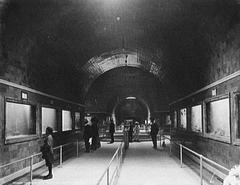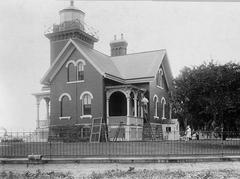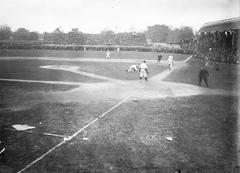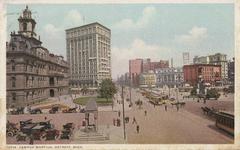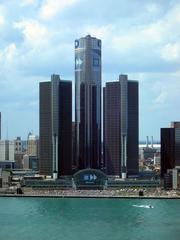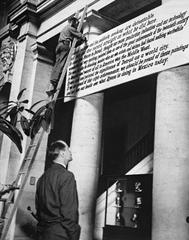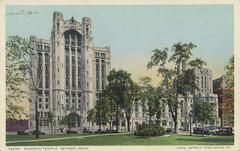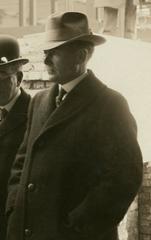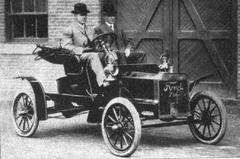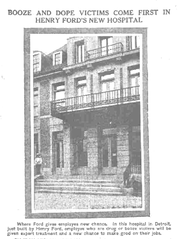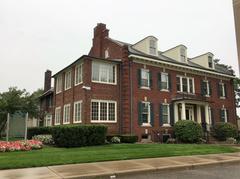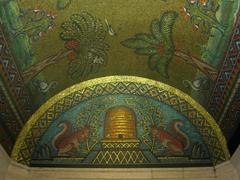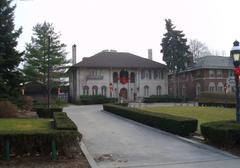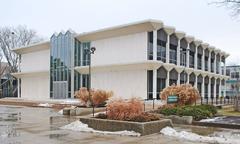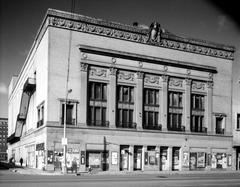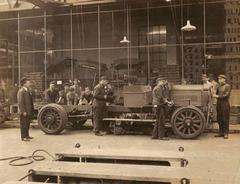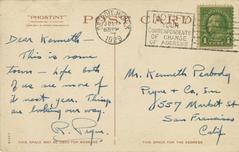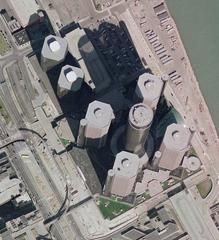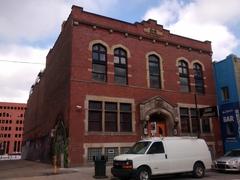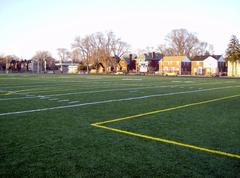
Mulford T. Hunter House: Visiting Hours, Tickets, and Detroit Historical Sites Guide
Date: 04/07/2025
Introduction
The Mulford T. Hunter House, nestled in Detroit’s vibrant Midtown neighborhood, stands as a lasting emblem of the city’s Gilded Age prosperity and architectural artistry. Built in 1894 by the renowned firm Donaldson & Meier, this Queen Anne-style townhouse is a rare survivor of late 19th-century elegance and upper-middle-class life in Detroit. Though the Hunter House remains a private residence, its richly detailed exterior and historic presence make it a highlight on Midtown’s architectural walking tours. This guide explores the house’s history, architectural features, visitor tips, and connections to Detroit’s broader cultural landscape, providing everything you need to enrich your visit to one of Detroit’s most cherished historic sites.
Table of Contents
- Introduction
- Historical Context
- Architectural Features and Style
- Visiting Information
- Preservation and Recognition
- Frequently Asked Questions (FAQ)
- Conclusion and Call to Action
- Visuals and Internal Links
- References
Historical Context
The Warren-Prentis Historic District
The Mulford T. Hunter House is located in the Warren-Prentis Historic District, an area characterized by over 100 architecturally significant buildings that narrate Detroit’s transformation from rural farmland to a booming urban center in the late 19th century. The district’s development, spurred by expanding streetcar lines, attracted wealthy professionals and industrialists who built stately homes reflecting their social status. Notable neighboring structures include the Perry McAdow House and the William C. Boydell House, each contributing to the district’s enduring historic character (Detroit Historical Society).
Construction and Ownership
Completed in 1894 for Mulford T. Hunter—a successful Great Lakes steamship captain—the house became a family home for several generations. The property was later sold and converted into apartments in 1951, mirroring broader residential trends in Detroit during the 20th century. Despite changes in use, the home’s exterior remains well-preserved, serving as an artifact of Detroit’s Gilded Age aspirations (Wikipedia).
Architectural Features and Style
The Hunter House is a textbook example of Queen Anne architecture, known for its eclectic detailing and asymmetry. Key features include:
- A raised stone basement supporting red brick walls
- An asymmetrical façade with a prominent bay window and a one-story porch supported by Ionic columns
- Ornate brickwork framing an oval second-story window and an elliptical fanlight above the entrance, set within a distinctive Syrian arch
- Leaded glass dormer windows and intricate decorative elements on the roofline
- Original slate roofing and preserved exterior woodwork
Adjacent to the George W. Loomer House, the Hunter House is one of only two remaining 19th-century townhouses in its area, offering a rare glimpse into Midtown’s fashionable residential past (Detroit1701.org).
Visiting Information
Hours and Tickets
- Interior Access: The Hunter House is a private residence; there are no public interior tours or regular ticketed entry.
- Exterior Viewing: Visitors are welcome to view and photograph the exterior from public sidewalks during daylight hours (recommended between 9:00 AM and 6:00 PM).
- Guided Tours: The house is often included as a highlight on local historical and architectural walking tours. Tour tickets can be purchased through organizations like Preservation Detroit and Show Me Detroit Tours.
Accessibility
- Sidewalks: The surrounding district is pedestrian-friendly, though some sidewalks may be uneven due to the area’s age.
- Mobility: There is no public access to the interior. For walking tours, contact organizers regarding specific accessibility needs.
Guided Tours and Travel Tips
- Book in Advance: Walking tours often require advance booking, especially during peak seasons.
- Comfort: Dress for the weather and wear comfortable shoes, as tours are primarily outdoors.
- Public Transit: Midtown is accessible via the QLine streetcar and city bus routes. Paid parking is available near Wayne State University and major museums.
Nearby Attractions and Photographic Spots
- Detroit Institute of Arts (DIA): Home to world-class art collections and the iconic Diego Rivera murals (DIA).
- Detroit Historical Museum: Explore immersive exhibits on Detroit’s urban history (Detroit Historical Museum).
- The Whitney: A Gilded Age mansion repurposed as a fine dining restaurant (The Whitney).
- Scarab Club: A historic arts venue with rotating exhibits (Scarab Club).
- Local Eateries: Midtown features a wide range of dining and coffee options for a complete day’s itinerary.
Photography is encouraged from public spaces—be sure to capture the house’s detailed brickwork, windows, and neighboring historic homes.
Preservation and Recognition
The Mulford T. Hunter House was listed on the National Register of Historic Places in 1994, affirming its architectural and cultural importance to Detroit. Local organizations such as Preservation Detroit continue to advocate for the protection and appreciation of the city’s historic sites. The house’s continued maintenance, despite being converted to apartments, reflects a broader commitment to preserving Detroit’s unique urban heritage.
Frequently Asked Questions (FAQ)
Q: Can I tour the interior of the Mulford T. Hunter House?
A: No, the house is a private residence. Only exterior viewing is permitted from public sidewalks.
Q: Are tickets required to visit?
A: No tickets are needed to view the exterior. Tickets are required for guided walking tours that include the Hunter House as a stop.
Q: When is the best time to visit?
A: Daylight hours between 9:00 AM and 6:00 PM offer optimal views and safety.
Q: Is the site accessible to people with disabilities?
A: Sidewalks are generally accessible, but some may be uneven. There is no interior public access.
Q: What other attractions are nearby?
A: The Detroit Institute of Arts, Detroit Historical Museum, and The Whitney are all within a short walk.
Q: Can I take photographs?
A: Yes, exterior photography from public spaces is encouraged. Please respect the privacy of residents.
Conclusion and Call to Action
The Mulford T. Hunter House stands as a significant piece of Detroit’s architectural and cultural tapestry. While interior access is restricted, its exterior offers a tangible connection to the city’s Gilded Age history and ongoing revitalization. Enhance your visit by joining a guided walking tour, exploring nearby museums, and supporting preservation organizations dedicated to Detroit’s historic sites.
For the latest updates, virtual tours, and curated guides, download the Audiala app and follow local preservation groups on social media. By engaging with Detroit’s heritage, you help sustain the stories and sites that define the city’s unique character.
Visuals and Internal Links
- Detroit Historical Society
- Preservation Detroit
- Show Me Detroit Tours
- Detroit Institute of Arts
- The Whitney
- Scarab Club
- TourDetroit.com
- Detroit1701.org
- Wikipedia: Mulford T. Hunter House
- RAW Detroit
References
- Visiting the Mulford T. Hunter House: History, Tours, and Detroit’s Historic Sites, 2025, Detroit Historical Society (Detroit Historical Society)
- Exploring the Mulford T. Hunter House: Detroit’s Queen Anne Architectural Gem and Historic Site, 2025, Preservation Detroit (Preservation Detroit)
- Visiting the Mulford T. Hunter House: History, Hours, Tickets, and Nearby Detroit Attractions, 2025, RAW Detroit (RAW Detroit)
- Visiting the Mulford T. Hunter House: Hours, Tickets, and Historical Significance of Detroit’s Iconic Queen Anne Home, 2025, Wikipedia (Wikipedia)
- Show Me Detroit Tours, 2025 (Show Me Detroit Tours)
- Detroit Institute of Arts, 2025 (Detroit Institute of Arts)


